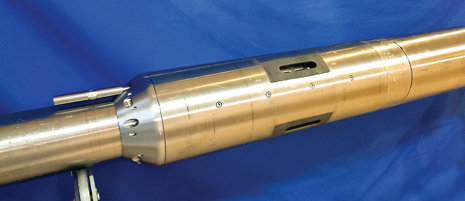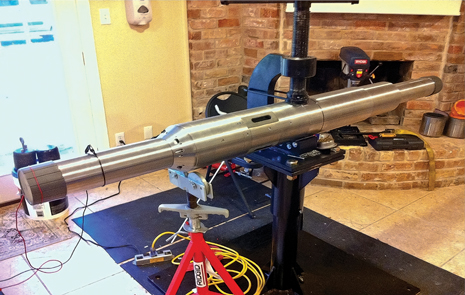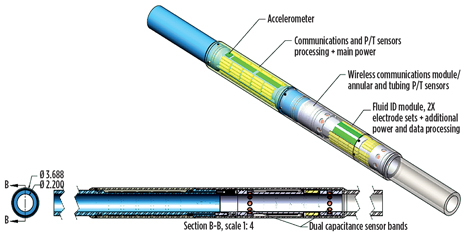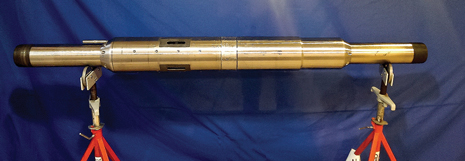JAMES M. PAPPAS, P.E., Research Partnership to Secure Energy for America
 |
| A close-up of the intelligent production system. |
|
A project was completed recently, on behalf of the Research Partnership to Secure Energy for America (RPSEA), which involved constructing a wireless communication system for downhole wellbore use. The objective of RPSEA Project 09121-3500-01, led by a team from Tubel, LLC, was to develop a safe system, for ultra-deepwater deployment, that would optimize production in multi-lateral wells and increase well life, while simultaneously decreasing production costs.
The system was to provide remote flow control capabilities inside the laterals, using an electric, ultra-low-power choke assembly. The system also needed the capability to collect real-time production data, and the ability to wirelessly transfer both data and power from the main bore, to the laterals. Furthermore, the power transfer could also be accomplished from the upper to lower completion, over long distances, so that gauges, and flow-control modules, could be deployed closer to the producing zones in the wellbore.
SCOPE
A system was constructed to provide a new way to control, and monitor, production by integrating sensors into the flow-control device, Figs. 1 and 2. This would be done while it was operating at ultra-low power. The opening, and closing, of the flow control requires 1.2 W of power, compared to the 50 W currently required for inner sleeve-based, electric flow control systems. The new system also has four flow-control ports that provide production control flexibility, by being able to choke the flow with minimal erosion. The flow control provides a larger ID, and smaller OD, than normal. This allows higher flowrates through the tool. It also enables system installation in smaller-diameter casing strings, which may save the operator a significant amount of money.
 |
| Fig. 1. Flow-control tool with sensors. |
|
 |
| Fig. 2. Sensor package design for laterals. |
|
The project succeeded in addressing a number of issues:
- Reduced number of feed-through connectors in the wellhead
- Utilization of a single electric line, for flow control and sensors, in the well
- Integration of sensors with flow-control tools
- Deployment capability, in laterals, of sensors and flow-control tools
- Power deployment in laterals
- Digital wireless communications in laterals
- Wireless power and communications transfer from the upper to the lower completion
- Battery-operated flow-control tools
- Availability of pressure, temperature, flow, and fluid identification sensors for permanent well deployment
- Through-tubing sensors and flow-control tools deployment
- Reliability improvement, for downhole systems, over existing systems—all sensors are incorporated in the new flow-control tool housing
- Potential flow-control tool deployment closer to the sand face in the lower completion.
The utilization of a new, low-power, high-reliability, high-temperature motor technology for the actuation of the flow-control tools will increase their use, as the technology is adopted. The low power allows the system to work, using batteries, for an extended period of time. In addition, new technologies will be incorporated into this unique system, which will result in other applications and tools.
CONCLUSIONS
The new system will have a significant impact on production, the environment and safety:
- It will minimize the environmental impacts associated with production, by reducing both the number of wells drilled and the number of well interventions.
- The reduction in the number of wells drilled, which will be accompanied by a smaller physical footprint, will occur, because multilateral production will become much more efficient.
- The reduction in the number of well interventions, as well as fewer wells, will reduce the chance for accidents that can affect wellsite safety.
- Fewer leak paths at the surface and downstream, as fewer flowlines, from wells to manifolds and surface facilities, translate into improved monitoring and control, less chance for leaks, reduced accidental risk, and more centralized control.
- It will optimize production from laterals, which can be controlled from a remote location at the surface.
- Increased production will result from well flow optimization, using downhole controls and remote monitors.
- More precise control, and optimization, in multi-completion wells, will occur, due to sensor and flow control deployment closer to, or at, the sand face, instead of at the bottom of the upper completion.
- The cost to develop, and produce, resources will be reduced. This reduction will be achieved by improving performance over the life of a well, and the consequent ability to shut off high water (in water breakthrough scenarios), or gas (in solution gas drive or gas cap breakthrough scenarios) flow, closer to the problem source, as soon as necessitated or realized.
- Efficiency will be increased. Controlling production in laterals, by dividing the systems into multiple producing zones within laterals, will allow for production from the toe of the well, instead of mostly from the heel of the lateral, as is common.
To summarize, the “Intelligent Production System for Ultra-deepwater with Short Hop Wireless Power and Wireless Data Transfer for Lateral Production Control and Optimization” project proved the following technological improvements, or breakthroughs:
- Wireless power transfer. This provides the ability to transfer electricity between two points in a wellbore. The applications, in a stand-alone mode, include energy transfer between the main bore and laterals, as well as energy transfer between upper and lower completion modules.
- Wireless communications transfer. This allows for a short hop of two-way communications between downhole modules. The applications include communications between the main bore and laterals; a permanently deployed module and a receiver module that are deployed in a well via slick line or electric line to retrieve the data; upper and lower completion modules; and/or seals or barriers in a well.
- Low-power, high-stability sensors. These are pressure sensors using sapphire windows. They are quite stable, under wellbore conditions, and provide a very simple calibration process to maintain accuracy. These low-cost systems can be deployed in multiple downhole applications to instrument most completion tools.
- Low-power flow-control system. This could revolutionize the completions sector of the oil and gas industry. The new system offers multiple features for existing, and future, applications, such as:
- Multiple systems that can operate on a single, downhole cable, due to the low power and small voltage losses on the cable.
- Elimination of the single inner sleeve used to control the flow in the well.
- Development of small sliding sleeves that can be controlled individually from the surface to open and close multiple sections, choke flow for reservoir/production management of flow, and/or slow the encroachment of water, or gas, into the flow stream.
- Ultra-low power requirement to operate the flow-control device. This will facilitate the development of other devices that can be used to manipulate the flow in the well such as gas lift valves, circulating valves, etc.
- Reduced number of feed-through connectors at the wellhead. This increases safety and reliability, while decreasing overall system costs.
- A new line of battery-operated flow-control tools can be developed, which will not require downhole cables for operation. These new systems can be deployed in existing (brownfield) wells, creating a new product line for operations in wells that may shut in or provide other means of control from the surface.
- Integration of sensor technology in completion tools. This allows multiple sensors to be deployed as part of the flow-control system. The use of these sensors will improve system reliability by eliminating additional splices on the downhole cable and reducing the number of electronic components required for data acquisition and communications.
- Integrated surface system. This will provide an integrated command, control and communications module, capable of directing downhole systems to acquire, and transmit, data to the surface, as well as to command various flow-control modules to open and close. It can process the data and interface with other systems at the well site.
RECOMMENDATIONS
Additional applications for the system (Fig. 3) will be created, and more products will be developed, to address other requirements, for completions and production. Some of the recommendations for the improvement, and leveraging, of the technologies developed are:
- Sensor integration technology utilization, to comply with new governmental regulations that will require sensors to monitor devices that seal, or control, production in a well.
- Integration of multiple completion tools, such as packers, flow-control modules and sensor technology, into a single package.
- Battery-based technology, to use expansion for flow control, perhaps for well cementing applications, too.
- Development of a high-temperature system capable of operating in temperatures up to 200°C (392°F).
- Wireless power transfer utilization to bypass downhole tools, such as packers, and eliminate costly feed-through connectors.
 |
| Fig. 3. The intelligent production system. |
|
The utilization of downhole power generators may also provide more flexibility for downhole flow control and sensor technologies, by allowing the wellbore to become a network of sensors. With such a capability, a system could be deployed anywhere in a well. Additionally, a system could be programmed to connect to, and integrate with, automated optimization software that could fully control each segment, or node, of each lateral and the main bore of a well. It also could self-adjust to maximize a well’s value, or to prevent an accident due to human error. 
ACKNOWLEDGEMENTS
The author would like to thank Tubel LLC and researcher Paul Tubel, the University of Houston and Chevron, for their efforts and support.
RPSEA is a 501(c)(3) organization that is entrusted with managing research and development projects for the U.S. Department of Energy’s National Energy Technology Laboratory, which was established pursuant to Title IX, Subtitle J, Section 999, of the Energy Policy Act of 2005.
|
The author
JAMES PAPPAS is V.P. of Ultra-Deepwater Programs for RPSEA. He has held the positions of global technology coordinator, facilities engineer in the Deepwater & International Well Engineering & Facilities Division, deepwater project coordinator for Devon Energy in the past, as well as production engineer in the Gulf of Mexico Division for Devon, and Santa Fe Snyder. He has also held drilling, completions, production, operations, reservoir, and A&D positions. Mr. Pappas earned a BS degree in Chemical Engineering and a BA in Chemistry from the University of Texas at Austin in 1979. He graduated with an MBA, with highest honors, from the University of Texas at Tyler in 1993. |
|






